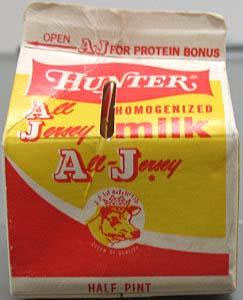State Beverage of North Carolina: Milk
by Steven Case, T. Mike Childs, Kelly Agan and Amy Kemp.
NC Government & Heritage Library, 2007. Updated 2017.
See also: North Carolina State Symbols and Official Adoptions main page
The General Assembly adopted milk as the official State Beverage on June 12, 1987. (North Carolina Session Laws, 1987, c. 347).
 Selection of State Beverage
Selection of State Beverage
The designation was requested by the state Milk Commission (established in 1947), and introduced by Senator Aaron W. Plyler, a Democrat from Union County. According to Representative Charles Beall, the bill had the support of the North Carolina farmers and most of the cows. The bill passed in the Senate with a vote of 39 to 3. In the House, it received 93 votes yes, 3 votes no, and several humorous votes “moo.” Opposition to the bill cited the desire to keep from cluttering the state statues. One representative voted no due to a desire for a state beverage with special ties to North Carolina, such as Pepsi-Cola, founded in New Bern.
The bill became law on June 12, 1987. At that time, North Carolina cows produced 179 million gallons of milk a year, earning approximately $4,800 per cow.
In making milk the official state beverage, North Carolina followed 17 other states, including both South Carolina and Virginia.
About Milk
Milk is a mixture of fat and protein in water, with dissolved sugar, minerals, and vitamins. It is high in nutritional value and contains all essential amino acids. Most notably, milk is high in calcium and phosphorus which helps with bone development.
Milk sours because of the microorganisms within it living and developing. Cooling the milk reduces the spread of the spoilage bacteria, making the milk last longer.
North Carolina bans the sale of raw milk for human consumption. Milk must go through a pasteurization process, sterilizing the milk by raising it to a high temperature to destroy harmful bacteria. Much of milk that is sold has also been homogenized, or forced under high pressure through small holes to evenly distribute the fat.
The number of milk cows and milk production in North Carolina declined between 2000 and 2010, but is slowly rising again. As of 2017, North Carolina had about 45,000 milk cows and ranked 29th in national milk production. Dairy is the 9th largest farm product in North Carolina. About 135 million gallons are sold per year, with an annual revenue of $165 million. North Carolinians alone drink over 143 million gallons of milk a year.
References and additional resources:
Agricultural Statistics: 2016 Annual Statistics Book. NC Department of Agriculture and Consumer Services. Online at http://www.ncagr.gov/stats/
NASS QuickStats Search Page (Statistics from the USDA/National Agricultural Statistics Service).
Associated Press. “Senator finds milk hard to swallow.” The New Bern Sun-Journal. April 30, 1987. A11.
"Milk." Encyclopædia Britannica. https://www.britannica.com/topic/milk.
North Carolina State Symbols. https://www.sosnc.gov/kidspg/symbols.htm.
"2016 State Agriculture Overview." United States Department of Agriculture. https://www.nass.usda.gov/Quick_Stats/Ag_Overview/stateOverview.php?stat....
Associated Press. "N.C. SENATE VOTES TO MAKE MILK THE STATE BEVERAGE," Charlotte Observer, The (NC), April 30, 1987: 4C.
Associated Press. "HOUSE MOO-VE MAKES MILK OFFICIAL N.C. BEVERAGE," Charlotte Observer, The (NC), June 12, 1987: 1A.
Image Credits:
[Hunter Jersey Farms, Inc., Charlotte, N.C., milk carton]. Photograph. Item H.1993.482.26, North Carolina Museum of History. (accessed December 11, 2014).
1 February 2000 | Case, Steven; Childs, T. Mike; Kemp, Amy